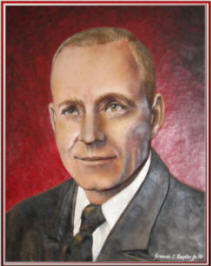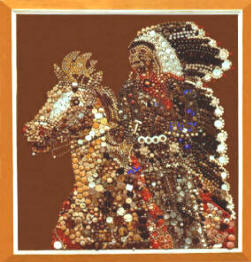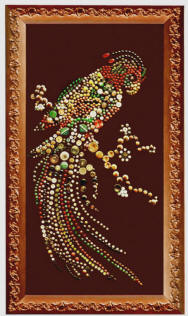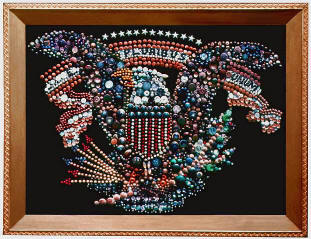 The
Man - His name was Norman C. Engler. He was a
member of the National Button Society. He was a member and Chairman of
the Board of the Minnesota State Button Society in the early 1940s.
Later he was President of the Kansas State Button Society and remained a
member of all three of these societies into the 1950s. Most importantly,
he was an artist who loved buttons and used them to create fascinating
mosaic pictures that portrayed a remarkable panorama of American
history.
The
Man - His name was Norman C. Engler. He was a
member of the National Button Society. He was a member and Chairman of
the Board of the Minnesota State Button Society in the early 1940s.
Later he was President of the Kansas State Button Society and remained a
member of all three of these societies into the 1950s. Most importantly,
he was an artist who loved buttons and used them to create fascinating
mosaic pictures that portrayed a remarkable panorama of American
history.
The Quest
- I came to know of Norman Engler in late 2007 after stumbling upon some
postcards that contained images of folk art of impressive achievement.
My initial research uncovered an article in the September, 1950 National
Button Bulletin that identified Mr. Engler as the artist and creator. My
interest in this art was initiated based on several cards of buttons in
the collection handed down to me from my grandmother. She had created
four cards of buttons that were mounted in the form of pictures
including a southern belle made from calico buttons and a flower basket
created from a wide and colorful range of buttons. Today, we would call
her effort creative mounting. While it was simple, I thought of it in
terms of her artful touch. So when I saw the large and complex mosaic
pictures by Norman Engler, I was hooked and the search was on.
 My
button friends responded to my questions with additional pictures of the
mosaic art, new examples of postcards showing the mosaics, and a special
assist from a Missouri collector who knew that many of the mosaics
remained with Norman Engler’s son, Peter Engler, in Branson, Missouri.
Peter Engler graciously agreed to assist me in my research of his
father’s work and in February, 2008, I traveled to Branson to learn more
and photograph the mosaics. My initial goal was to simply make the
digital images and background information available to other collectors
with like interest. Once there however, my goals expanded. It was clear
that 75 years of transporting, showing, and storing the mosaics had
taken a significant toll. I became motivated to digitally restore both
the images I took in Branson and the images on film taken more than 50
years earlier. My goal was to preserve the mosaics, using pictures, so
that button and folk art enthusiasts could continue to see the mosaics
in a condition that would better represent their original state. It took
more than six months to accomplish this task. The results are imperfect
and I regret any errors that have crept in due to such factors as
"guessing" the original fabric colors or "fixing" some of the buttons,
mainly celluloid, that have predictably self-destructed with time.
My
button friends responded to my questions with additional pictures of the
mosaic art, new examples of postcards showing the mosaics, and a special
assist from a Missouri collector who knew that many of the mosaics
remained with Norman Engler’s son, Peter Engler, in Branson, Missouri.
Peter Engler graciously agreed to assist me in my research of his
father’s work and in February, 2008, I traveled to Branson to learn more
and photograph the mosaics. My initial goal was to simply make the
digital images and background information available to other collectors
with like interest. Once there however, my goals expanded. It was clear
that 75 years of transporting, showing, and storing the mosaics had
taken a significant toll. I became motivated to digitally restore both
the images I took in Branson and the images on film taken more than 50
years earlier. My goal was to preserve the mosaics, using pictures, so
that button and folk art enthusiasts could continue to see the mosaics
in a condition that would better represent their original state. It took
more than six months to accomplish this task. The results are imperfect
and I regret any errors that have crept in due to such factors as
"guessing" the original fabric colors or "fixing" some of the buttons,
mainly celluloid, that have predictably self-destructed with time.
 The
History – Norman Engler was born in Jordan, Minnesota in
1893. He married Ida Carter who became an integral part of the team that
created the mosaics. They both came from families of collectors and
their grandmothers, who were described as hopelessly romantic, had
assembled charm strings that were passed down to Norman and Ida.
Although newspaper accounts vary, their idea to create a unique way to
display buttons was inspired in the late 1920s after seeing the creative
display of buttons either at a PTA meeting, a state fair, or a bazaar -
probably all three. Before the mid-1930s they had created several of the
button mosaics starting with the Parrot and Peacock and finished the
last of the mosaics, The Last Supper, in the mid-1950s. Ida, who had
once created oil paintings, performed research and prepared sketches and
Norman assembled the buttons into the mosaics and did the sewing. Ida
once opined that “while Norman was a genius at sewing buttons on the
cloth backgrounds for pictures, he was unable to sew a button on a
shirt.” Mr. Engler was a salesman for a Kansas salt company and was able
to engage his clients in discussions of hobbies and became the recipient
of numerous button donations. He stated that many of the donors would
never sell their family buttons but gave them to him to be displayed in
his art. He died in Fayetteville, Arkansas in 1958.
The
History – Norman Engler was born in Jordan, Minnesota in
1893. He married Ida Carter who became an integral part of the team that
created the mosaics. They both came from families of collectors and
their grandmothers, who were described as hopelessly romantic, had
assembled charm strings that were passed down to Norman and Ida.
Although newspaper accounts vary, their idea to create a unique way to
display buttons was inspired in the late 1920s after seeing the creative
display of buttons either at a PTA meeting, a state fair, or a bazaar -
probably all three. Before the mid-1930s they had created several of the
button mosaics starting with the Parrot and Peacock and finished the
last of the mosaics, The Last Supper, in the mid-1950s. Ida, who had
once created oil paintings, performed research and prepared sketches and
Norman assembled the buttons into the mosaics and did the sewing. Ida
once opined that “while Norman was a genius at sewing buttons on the
cloth backgrounds for pictures, he was unable to sew a button on a
shirt.” Mr. Engler was a salesman for a Kansas salt company and was able
to engage his clients in discussions of hobbies and became the recipient
of numerous button donations. He stated that many of the donors would
never sell their family buttons but gave them to him to be displayed in
his art. He died in Fayetteville, Arkansas in 1958.
The Mosaics
– The Englers created a series of 16 button mosaic pictures
between about 1930 and 1955. They ranged from two by two and a half feet
to eight by three plus feet. The number of buttons used varied widely.
The first mosaic, the Parrot, was made from slightly less than a
thousand buttons while Pilgrims Going to Church used about 60,000
buttons. This latter work has a background formed solidly of buttons,
which contrast with a second and third layer of buttons used to outline
the picture. He used a “no harm” practice of attachment and explained
that “every button is fastened with three stitches of linen thread
coated with bee’s wax for permanent preservation.” He estimated that an
average of 1000 hours went into the sewing of the buttons. Considering
the mosaic of Chief Crazy Horse with 20,000 buttons, sewing on one
button every minute would take about 350 hours. Taking into account the
time for selection, placement, and rework, the actual time would be
several fold greater.
 His
work won many awards including blue ribbons at the 1941 and 1942
National Hobby Shows for Chief Crazy Horse and Spirit of 76
respectively. His Country Church mosaic won the sweepstakes prize at
the National Button Show in Chicago in 1942. From a 1944 interview in
the Hutchinson Kansas News, Mr. Engler stated “My favorite is the
smallest and the least brilliant of the lot. It is the scene - only two
feet square - of a plain little Country Church against a background of
quiet snow. The beauty of the shifting variety of lights coming from the
one small window seems almost perfect to me.” He said he would never
consider selling any of the mosaics - and he never did.
His
work won many awards including blue ribbons at the 1941 and 1942
National Hobby Shows for Chief Crazy Horse and Spirit of 76
respectively. His Country Church mosaic won the sweepstakes prize at
the National Button Show in Chicago in 1942. From a 1944 interview in
the Hutchinson Kansas News, Mr. Engler stated “My favorite is the
smallest and the least brilliant of the lot. It is the scene - only two
feet square - of a plain little Country Church against a background of
quiet snow. The beauty of the shifting variety of lights coming from the
one small window seems almost perfect to me.” He said he would never
consider selling any of the mosaics - and he never did.
The difficulties in taking care of the collection were significant. For
a number of years Mr. Engler exhibited in museums, hobby and button
shows, button society meetings and even events for school children. But,
as he stated, “very seldom was a picture returned with all its parts
still sewed on straight.” Seeing them in person makes it clear as to the
size of the challenge. Some are very large and heavy. Consider that
Dawning of a new Day is eight feet by four feet in a heavy antique frame
or that Pilgrims Going to Church is more than four feet by five feet
with 60,000 buttons. The effort to preserve the mosaics was the main
reason for the Englers moving to Arkansas where, in the early 1950s,
they displayed the mosaics in their large gift shop and soda fountain
named “Where-Away." The name “Where-Away” comes from a poem by
James Whitcomb Riley, which describes a man’s search for something he
never finds. They were a major tourist attraction in the area near Bull
Shoals Dam. Engler described an unusual but effective plan for cleaning
the mosaics when they lived in Minnesota. When a hard driving snow storm
came, he’d take the pictures outside and stake them down. The wind would
whip through the buttons and remove the dust, like sand blasting. He
explained that “the snow there is dry, and will brush off without making
a spot. Because Arkansas snow is moist, this method isn’t possible in
Arkansas”.
 The Accolades and Anecdotes
– Among the letters and newspaper articles
graciously provided from Peter Engler’s scrapbook, there are many
accolades for the work of his father and mother. For example, in a
letter reporting on the December, 1943 Minnesota State Button Meeting,
Ethel Hillis, President of the Minnesota State Button Society writes:
“Our November gathering was in keeping with our objectives and goal – an
inspirational meeting. The piece-de-resistance of the meeting was the
talk of Chairman Norman C. Engler of the Board of Directors, of Mankato;
on the art of picture making with buttons and having on display one of
his famous pictures, “The Spirit of 76.” As both artist and collector,
Mr. Engler deserves all homage, his artistic workmanship deserving
National recognition and worthy of a better
write-up than I could give.”
The Accolades and Anecdotes
– Among the letters and newspaper articles
graciously provided from Peter Engler’s scrapbook, there are many
accolades for the work of his father and mother. For example, in a
letter reporting on the December, 1943 Minnesota State Button Meeting,
Ethel Hillis, President of the Minnesota State Button Society writes:
“Our November gathering was in keeping with our objectives and goal – an
inspirational meeting. The piece-de-resistance of the meeting was the
talk of Chairman Norman C. Engler of the Board of Directors, of Mankato;
on the art of picture making with buttons and having on display one of
his famous pictures, “The Spirit of 76.” As both artist and collector,
Mr. Engler deserves all homage, his artistic workmanship deserving
National recognition and worthy of a better
write-up than I could give.”
On a more humorous note, Mr. O. C. Lightner, editor of Hobbies-The
Magazine for Collectors provided advice to Norman Engler in a letter
dated May 13, 1942. He stated “I saw a lot of women looking at your
buttons and remarking that you spoiled some very good collectors’ items
by putting them in a pictorial of that kind. You could do that with
common buttons. You had some buttons there worth $1 or $2 apiece…… If I
were you and had a good many buttons, it would certainly pay to buy the
books, OLD BUTTONS & THEIR VALUES ($1.25) and BUTTON CLASSICS, ($5.00)."
In a Manhattan, Kansas Mercury newspaper article dated November 20, 1949
the writer raises the issue about naming the artwork. She states that
”The Englers call them ‘mosaics’. Art students murmur words like
‘impressionism’, ‘pointillism’, and ‘new medium’. Some folks insist
they’re merely ‘paintings’. But whatever these objects of art are
called, most critics agree that when seen as a whole, the content of
these 15 Engler frames make a remarkable panorama of American history.”
I certainly take no issue with the naming and neither does my version of
Webster’s dictionary. For those who enjoy history and nostalgia, I have
included a section, accessed from the "Mosaic Index", with the two
letters referenced above along with a 1942 Hobbies magazine report on
the “Highlights of the 3rd National Button Show”. Fun excerpts include
"buttons which were donated to the Society were auctioned off during the
show thus increasing the Society’s fund by $90.35" and "The Monadnock,
N. H. Button Club, with a small membership, started to raise money about
two years ago to send a delegate to the 1941 National Button Show. By
small button gifts to the club treasury, bridge parties, and other local
events, they achieved their goal, and sent Mrs. Dorothy Morey, club
president, to bring back news of the big event.”
 The
Digital Tour – My imperfect attempt to digitally
restore images of the 16 mosaics to an earlier, more original condition
was flawed for several reasons. First was the skill of this author.
Second was the deterioration of the mosaics, especially the frames and
background fabrics as a result of 75 plus years of handling,
transportation, and the elements. (Who among you will reach 75 without
some significant deterioration?) The third challenge relates to the
images themselves. For the nine mosaics I was able to photograph, the
challenge was mainly one of getting images sharp enough to see the
buttons, dealing with the normal distortions that occur when you
photograph a large object up close, and guessing at original colors. For
the seven I could not photograph, old 35mm film and slides were provided
by Peter Engler which, as would be expected, have significantly faded
with age and lack the resolution to magnify the images. No whining here.
Just an explanation that some of the images you will see are fairly
sharp with excerpts magnified so you can see the details of some of the
individual buttons used in the mosaics. The remaining nine from the
older film could not be shown to the same detail as the contemporary
images but are included so you can experience the whole family of
mosaics. Click on the following button and enjoy.
The
Digital Tour – My imperfect attempt to digitally
restore images of the 16 mosaics to an earlier, more original condition
was flawed for several reasons. First was the skill of this author.
Second was the deterioration of the mosaics, especially the frames and
background fabrics as a result of 75 plus years of handling,
transportation, and the elements. (Who among you will reach 75 without
some significant deterioration?) The third challenge relates to the
images themselves. For the nine mosaics I was able to photograph, the
challenge was mainly one of getting images sharp enough to see the
buttons, dealing with the normal distortions that occur when you
photograph a large object up close, and guessing at original colors. For
the seven I could not photograph, old 35mm film and slides were provided
by Peter Engler which, as would be expected, have significantly faded
with age and lack the resolution to magnify the images. No whining here.
Just an explanation that some of the images you will see are fairly
sharp with excerpts magnified so you can see the details of some of the
individual buttons used in the mosaics. The remaining nine from the
older film could not be shown to the same detail as the contemporary
images but are included so you can experience the whole family of
mosaics. Click on the following button and enjoy.
 The
Acknowledgements – I extend my sincere appreciation
to Peter Engler for sharing the mosaics, his family scrapbook, and other
biographical materials. I also thank him for allowing me to publish the
results of my effort on the Button Country website for the enjoyment of
button collectors everywhere. I also thank his colleagues and staff for
their assistance in gathering materials and assisting with the
photography. Anyone traveling in the Branson, Missouri area should visit
the Peter Engler Designs shop where you may be able to see one of the
button mosaics on display. The wonderful woodcarvings by many artists
will take your breath away. I am also grateful to the many collectors
and friends who have sent me photographs, postcards, relevant
information on the mosaics, and other examples of folk art using
buttons. Special thanks to Carol Janovsky, a Buttonbytes friend, who
identified the location of the mosaics and put me in touch with Peter
Engler. Thanks to all who have helped. The picture of Norman Engler at
the top of this page is a hand carved, painted portrait created by his
son, Norman Engler Jr. Surely there was a genetic predisposition to the
arts in the Engler family.
The
Acknowledgements – I extend my sincere appreciation
to Peter Engler for sharing the mosaics, his family scrapbook, and other
biographical materials. I also thank him for allowing me to publish the
results of my effort on the Button Country website for the enjoyment of
button collectors everywhere. I also thank his colleagues and staff for
their assistance in gathering materials and assisting with the
photography. Anyone traveling in the Branson, Missouri area should visit
the Peter Engler Designs shop where you may be able to see one of the
button mosaics on display. The wonderful woodcarvings by many artists
will take your breath away. I am also grateful to the many collectors
and friends who have sent me photographs, postcards, relevant
information on the mosaics, and other examples of folk art using
buttons. Special thanks to Carol Janovsky, a Buttonbytes friend, who
identified the location of the mosaics and put me in touch with Peter
Engler. Thanks to all who have helped. The picture of Norman Engler at
the top of this page is a hand carved, painted portrait created by his
son, Norman Engler Jr. Surely there was a genetic predisposition to the
arts in the Engler family.
